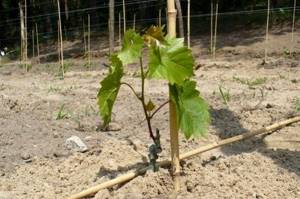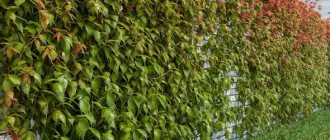To grow grapes and get a good harvest from them, of course, you need to put in a lot of physical effort and knowledge. And the basis of everything is planting quality material. Seedlings can be grafted, or they can be rooted. It is better to buy grafted ones from a trusted seller, and self-rooted ones are quite easily obtained from cuttings taken from the vine of the variety you like. But as in all matters, there are little secrets and nuances. After all, you can cut cuttings of some grape variety from your neighbor, but you won’t be able to get planting material. Either the roots do not appear during germination, or the plant turns out to be too weak and is constantly exposed to fungal diseases. The winegrower gives up. But the process of propagating grapes by cuttings is not at all complicated. We will tell you how to obtain high-quality planting material in this article.
Preparation of cuttings in autumn
Cutting the pipes is the first stage of work.
Propagation of grapes in spring by cuttings can be divided into three stages:
- harvesting cuttings in the fall;
- processing them and storing them;
- at the end of winter, prepare the cuttings for planting.
During pre-winter pruning, before the ambient temperature drops, it is necessary to prepare planting material . This is done at a time when the grape bushes have already dropped their leaves.
Necessary rules for selecting seedlings, following which the acclimatization of the plant will be successful:
- It is necessary to pay attention to the fact that the grape plant from which the chibouks will be cut is not damaged by fungal and other diseases. There should be no traces of phylloxera on the shoots;
- Infected vines and fallen leaves must be burned away from vineyards
- Thin or thickened, fattening shoots are not suitable. The cut branch should be green without the slightest brown inclusions;
- Chibouks are cut from the middle part of the vine, since the upper part does not have time to ripen sufficiently, and the lower part is more prone to damage and is less fertile;
- selected vines are freed from tendrils and unfallen leaves using pruning shears. And then cuttings of at least 40 cm in length and 8–10 mm in diameter are cut from them.
The pruning shears should be very sharp and not bite the vine. It's easy to check. It should cut thin paper easily.
Signs of a quality cutting
To successfully complete the work and so that the painstaking work is not in vain, it is necessary to select high-quality planting material:
- Cuttings are taken only from mature woody vines.
- The selected chibouk should be 50–70 cm in length and 8–10 mm in diameter.
- If possible, the cuttings should be smooth without any curvature.
- Planting material should only be brown in color, without the slightest mechanical damage .
- Each cutting that will later be planted must have at least four buds.
- High-quality planting material should be hard and crack slightly when bent.
If you are preparing cuttings of several varieties at once, do not forget to label them with paper tags so that you do not confuse them when planting them in the ground. This link will tell you about planting and caring for grapes in open ground.
Preparation of pipes - methods and timing
Winegrowers will confirm that at least 90% of all vines have to be removed from the bush during pruning and summer green operations. From all these trimmings you can always select a sufficient number of cuttings for rooting.
- During autumn pruning, lignified cuttings are cut. To do this, select fully mature annual vines without damage to the outer cover by diseases or pests. The top 1/3 of the vine is unsuitable for cuttings. For winter storage, cut stems with 3-4 internodes.
- Green cuttings of spring harvesting are obtained by breaking off unnecessary grape shoots. The thin tops of the vine are unsuitable for propagation. The diameter of the green shoot must be at least 8 mm.
Lignified cuttings harvested in autumn contain a significant supply of nutrients - if the technology is followed, their rooting rate approaches 100%.
Processing of pipes
The water content in grape cuttings has a great influence on their condition and further survival. If, due to improper storage, more than twenty percent of the liquid in the vine is lost, the risk that the seedling will not germinate increases significantly. Even prolonged soaking in water using various stimulants cannot correct the situation. Branches that have lost precious moisture do not take root well and do not produce buds. To avoid all these unpleasant consequences, cuttings are prepared for storage immediately after harvesting. Before planting them in a cool place, the planting material is treated with a 3% solution of copper, and possibly iron sulfate. To prepare it you will need a teaspoon of vitriol per 200 ml of water. To treat the cuttings, you need to spray them generously, or better yet, wash them with this solution. This procedure will rid the planting material of possible fungal diseases and mold. After treatment, it is necessary to thoroughly dry the vines in the open air until drops of water disappear on them. This will eliminate the possibility of them rotting. Find out how to grow grapes from seed in this article.
Storage Features
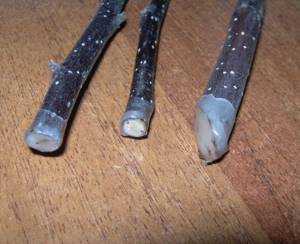
It is recommended to treat the ends of the cuttings in paraffin before storage.
During storage, grape seedlings can lose up to 50 percent of their nutrients, and this often weakens the plants so much that they become unsuitable for planting. Therefore, the main task is to ensure that the loss of useful microelements in the chibouks is minimal. Its successful storage until spring depends on the temperature in the room where the planting material is located . The lower it is, the slower the vital processes of plants proceed, which means the consumption of stored nutrients slows down. The optimal temperature in the cellar should be 0-4 degrees. This temperature regime will preserve most of the nutrients that will be necessary for the formation of future shoots and roots. If the storage room is too cold, the cuttings will dry out. Well, if the air temperature in the cellar is above four degrees, the buds may begin to bloom at the most inopportune moment. To stop this, it is necessary to artificially reduce the temperature in the room. This can be done by ventilation and also by increasing the relative humidity of the air. Read about rooting grape cuttings here.
There are several ways to store cuttings:
- the prepared and processed chibouks thoroughly with water and pack them in thick plastic bags , having previously made holes in them for ventilation. Once or twice a month they should be opened and carefully inspected for mold. If this happens, you need to carefully, without damaging the kidneys, remove it with a sponge soaked in a solution of vitriol. If the chibouks are dry, you will need to moisten them again.
- For the second method of storing planting material, you will need wet sand or sawdust from coniferous trees. The chibouks folded in a plastic bag are sprinkled with them liberally . With this storage, the cuttings will not dry out and their carbohydrate consumption will be significantly reduced.
- The third, fairly common method of storage is storage. A small hole is dug in the cellar, workpieces are placed in it and covered with soil. The soil prevents mold and fungi from developing, and also helps preserve the beneficial microelements contained in the cuttings.
You can dig up planting material for the winter in the basement in a box, filling it with slightly damp soil.
Germination methods
Growing cuttings at home, at first glance, seems like a difficult task. This is not entirely true. Anyone can cope with this task with patience, some effort and knowledge. But after proper germination, the seedlings can be safely planted in open ground with confidence that they will take root and, after a certain period of time, the grape plants will be pleased with the harvest. The procedure for rooting cuttings begins in February or early March. But first there is preparation:
- planting material is transferred from a cold basement to a warm room;
- then the cuttings must be disinfected in a weak solution of potassium permanganate. Slightly pink;
- rinse under running water;
- make two cuts with pruning shears. First bottom. Two to three centimeters below the outermost kidney. And the top refreshing cut.
You can root cuttings correctly using several methods: in water according to Radchevsky, “on a cabinet” according to Puzenko’s method, in peat tablets, in sawdust, in an aquarium, in a pit (Moldavian method).
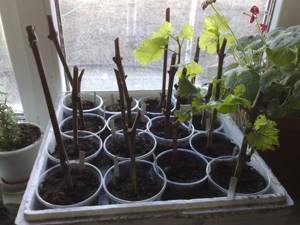
After roots appear on the cuttings, they are planted in containers with soil.
Into the ground
In the southern regions and the Black Sea region, germinating chibouks in open ground is practiced . They do this in late May early June:
- Choose a place to land. A hill with a slope to the south is best suited.
- Rotted manure and sand are added to the fluffy soil.
- The upper part of the cuttings is waxed in order to slow down the growth of the crown.
- Long stems (more than 40 cm) are planted in a hole with a slight slope to avoid deformation of the seedling.
- Water the plantings regularly to prevent the soil from drying out.
Germination in open ground has its advantages. Requires less time than rooting at home. You can plant planting material even when it was purchased in May or June. There are also disadvantages to such plantings. Not all branches take root, and the root system may not fully develop before the onset of cold weather. Read here when to germinate grape cuttings.
In Moldova, they practice rooting grapes in holes. To do this, a vine 60-80 cm long is twisted into rings in several turns and secured with twine. Then it is planted in a hole, leaving one or two buds above the ground. By autumn, the plant takes root well, and a year later it can already produce its first harvest.
Preparing seedlings at home
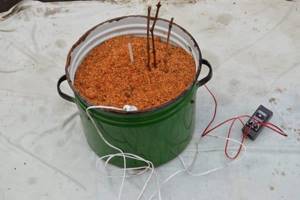
Using a cultivator significantly speeds up the rooting process of cuttings.
After winter storage, the suitability of the cuttings for planting is determined and they are subjected to the following treatment:
- Soak in water.
- Use pruning shears to refresh the lower and upper cuts.
- The eyes are removed from the lower nodes.
- Furrowing is carried out.
- Treated with growth stimulants.
- Subjected to kilching.
Preparing the stems for planting significantly speeds up the process of root formation, and after rooting, obtaining high-quality seedlings. Learn about currant cuttings in spring from this material.
Soaking the chibouks in water increases their humidity, which decreases during storage. Soak the planting material for 2–3 days in barrels, bathtubs and any suitable containers. The water temperature should be 15–16 degrees.
Refresh cuts. The lower cut is made straight two to three centimeters below the extreme node. The upper cut is made oblique 3–4 cm above the eye.
Furrowing involves making longitudinal cuts on the bottom of the shank with a garden saw. On its lower node. This is done to speed up the root formation process. In addition, this procedure reduces the time gap between shoot growth and rhizome development.
Kilching. The lower part of the cutting is placed in conditions of elevated temperature, and the upper part, on the contrary, is lowered. Due to this, callus and root primordia are formed. And in the upper part, thanks to this process, the development of the eyes slows down.
Planting chibuks in the fall is not practiced.
How to propagate grapes from green cuttings
To form a bush that is “transparent” to the sun’s rays, you have to break out many shoots. The fragmentation is carried out in the evening. Selected cuttings with a diameter of 8 mm or more are placed in water, sprayed and covered with a damp cloth.
If possible, planting should be done immediately. In extreme cases, chibouks can “survive” until the morning in the basement.
A necessary condition is that a pre-prepared seedling box or greenhouse-school is required.
- To cut cuttings, only the lower 2/3 of the broken vine is used - the weak thin top (1/3 of the length) is thrown away.
- The remaining vines are cut into cuttings consisting of 2 nodes: the lower straight cut immediately below the node (the leaf is broken), the upper oblique cut is at a distance of 1-2 cm from the node (the leaf plate is cut in half).
- After cutting, the cuttings are placed in a container of water as quickly as possible before they wilt.
- Everything is planted in a seedling box or school at a distance of 10 cm from each other, deepening the cuttings by 2-3 cm.
- The first 2 weeks after planting must be sprayed with warm water at least 4-5 times a day.
- After 2 weeks, when root buds begin to appear, the number of sprayings is reduced to 3 times a day. This stimulates the development of the root system.
- After another 2 weeks, the seedlings are transferred to root watering.
A prerequisite is that the schoolhouse (seedling box) must be covered throughout the entire rooting period. Direct sunlight should be avoided on immature seedlings until the cuttings become lignified.
If necessary, rooted chibouks are transplanted to a permanent place in September. For a quality winter, the preferable option is for the plants to remain in the school until spring.
conclusions
Propagation by cuttings has the following advantages :
- The process of breeding and growing grapes is much faster. You don’t have to wait for the seeds to germinate if you choose this option.
- You can grow your own root in the kitchen by placing the cuttings in a jar of water.
- You can have any grape variety you like in your garden plot. It will be enough just to get a piece of vine from the mother bush.
- When operations are performed correctly, the survival rate of own roots is quite high.
At the same time, such seedlings also have their disadvantages:
- Low frost resistance . That is, in the central regions it is better to plant grafted material.
- You need to store and harvest cuttings from a healthy bush , otherwise such seedlings will be plagued by diseases and the winegrower will have to constantly fight them.
Accelerated propagation of grapes from shortened cuttings
For many, the story of rooting cuttings in a jar, growing them in a schoolhouse, and then replanting may seem too complicated and long.
For too busy summer residents, there is a method that combines all 3 operations. For planting using the accelerated method, you will need stems from mature vines with a diameter of 8-10 mm.
The number of internodes is not of fundamental importance - after winter storage the cuttings must be soaked for 2 days and stratified.
Stratification is nothing more than keeping the chibouks in a damp, cool, dark place. The corresponding conditions arise if you wrap the pipes with a damp rag and place them in a black bag with ventilation holes for 2 weeks. Periodically, it is necessary to unwrap the bag and moisten the rag.
After stratification, the chubuk tree with root buds is planted in a shrub - this can be a greenhouse or greenhouse.
- The bed is prepared with a supply of nutrients for 2 years.
- Chubuki are planted at a distance of 10 cm from each other, at least 30 cm between rows.
- The chubuks are immersed in the soil up to the upper eye vertically or with a slight inclination.
- The planted cuttings are well watered and covered with glass or film.
Further care of the plantings does not differ from the usual method.
